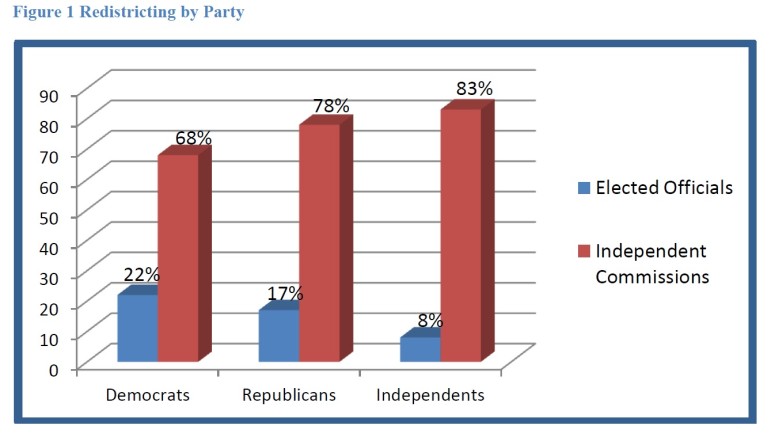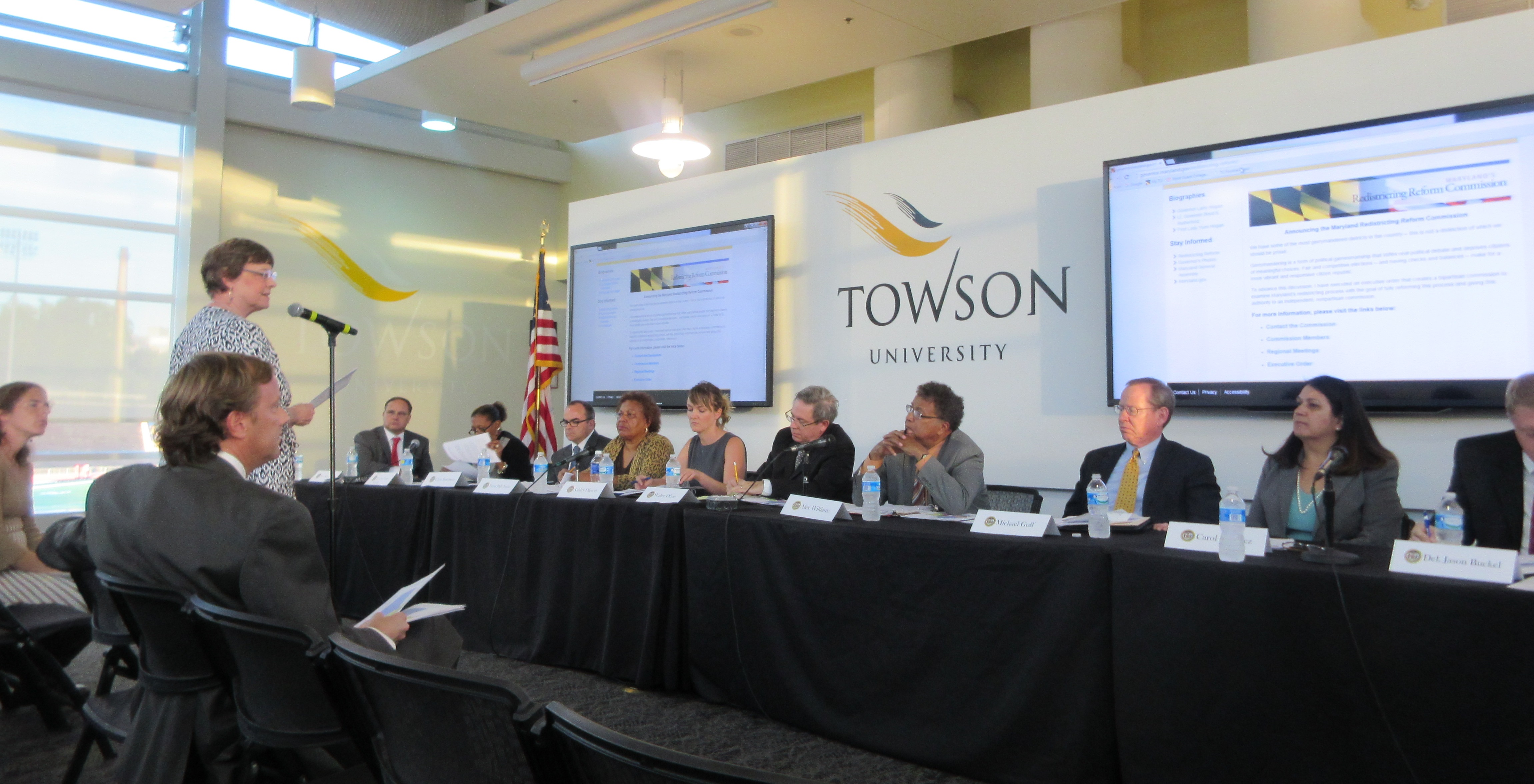By Len Lazarick
Len@MarylandReporter.com
Mostly Republicans and a few good government advocates lined up Tuesday night to tell the governor’s Redistricting Reform Commission why and how an independent commission ought to be created to take the politicians out of the partisan drawing of congressional and legislative district lines.
Then there was Sen. Jim Brochin, one of the few Democratic incumbents screwed in the 2011 legislative redistricting. The 11-member commission was sitting at Towson University at the bottom of Brochin’s 42nd district that once was clustered around the Baltimore County seat when he was first elected in 2002.
Then, after a series of votes that displeased Gov. Martin O’Malley, mostly against tax hikes and the repeal of the death penalty, Brochin’s district was redrawn to stretch from the Baltimore City line 25 miles north to the Pennsylvania border, adding some of the staunchest Republican territory in the state.
Retaliation
“This became a retaliatory move,” said Brochin, who unsuccessfully sued to block the plan. “This was done in strict retaliation.”
Known as a relentless campaigner used to winning by 5,500 to 6,000 votes, Brochin barely eked out a 1,500-vote victory against a Republican.
“I believe what the governor [Larry Hogan] is doing is very altruistic,” said Brochin. If Republican Hogan wins reelection in 2018, he could retaliate in reverse, drawing maps “ugly” for Democrats.
Brochin had pointed out that the 2002 maps were drawn quickly by the Maryland Court of Appeals after Gov. Parris Glendening’s original plan was challenged in court.
Brochin’s opponent, Republican Tim Robinson, a retired anesthesiologist, testified later in the hearing and agreed that the process needed to be changed since too many voters were shifted into different districts.
Robinson said he has four young adult children whose “perception is that is a corrupt system.” He noted that Mike Miller has been the Senate’s presiding officer for 28 years and that “looks corrupt.”
The commission hearing, the first of five scheduled around the state, was kicked off by co-chairman Alexander Williams, a retired federal judge, reading Hogan’s charge to the panel. He observed that half of the Towson campus was in the 3rd Congressional District and the other half was in the 2nd.
Not a fair process
“Maryland citizens know it is not a fair process,” said Lu Pierson, representing the League of Women Voters. She cited a Gonzales Research poll done in 2013 that found that 73% of all voters, including 68% of Democrats, supported an independent commission over the current system dominated by the governor and legislative leaders.

Results of 2013 Gonzales poll showing voters who said they back an independent commission to do redistricting.
Pierson said that 1.5 million voters in Maryland were moved from one district to another in the last congressional redistricting, and that this gerrymandering is one of the causes of voter apathy and “the unprecedented disappearance of the political center.”
She noted that while 40% of voters across the state voted for Republican congressional candidates, only one out of eight Maryland members of the U.S. House of Representatives (12.5%) is a Republican.
Pierson and many of the other two dozen witnesses who testified favored using the same standard for congressional districts as the Maryland constitution requires for legislative districts.
“Each legislative district shall consist of adjoining territory, be compact in form, and of substantially equal population. Due regard shall be given to natural boundaries and the boundaries of political subdivisions,” the constitution says. Even this provision doesn’t prevent political maneuvering, and the league and many witnesses wanted no elected officials or politically connected people involved in the process.
“We should not wait till Texas or North Carolina … get it right” — two prime examples of Republican gerrymandering — to act.
California gold standard
Jennifer Bevan-Dangel, executive director of Common Cause Maryland, cited examples from around the country of independent commissions for redistricting, with California “held up as one of the gold star models.” California used an “elaborate and complex” system to establish its commission, with members chosen by lottery from thousands of nominees. The legislature could throw out people with political axes to grind.
In Arizona, in a process recently upheld by the Supreme Court, legislative leaders selected from a pool of candidates to draw its district, Bevan-Dangel said. Iowa has one of the least political processes, using a computer “to kick beautiful square districts” in that very rectangular state.
Multi-member districts
House Minority Whip Kathy Szeliga raised an issue not even mentioned in Hogan’s executive order. She asked the commission to recommend single-member delegate districts, rather than the two- and three-member districts that predominate in Maryland.
“Almost every other state has thrown that out,” Szeliga said. She also asked the commission to change the population criteria in Maryland, which allows a variance of plus or minus 5% in population size. Federal court standards for congressional districts allow only 1% variance.
Szeliga’s Baltimore-Harford three-member district has one of the largest populations in the state, while some urban Democratic districts have almost 10% fewer people.
Del. Christian Miele, a new Republican from Baltimore County’s 8th District, said he favored single-member districts since it allows for more minority representation and better constituent service. He also favors an independent commission, and had sponsored legislation (HB906) to achieve both goals. But his commission would include members of the General Assembly.
Del. Eric Bromwell, a four-term Democrat from the same 8th District, was one of the few Democrats to testify in favor of reform.
“I think it has become a political process,” said Bromwell. “I think Maryland can be a leader,” and not wait for other states to reform their process.
One Democratic nay-sayer
Russell Kovach, a member of the Harford County Democratic Central Committee, was one of the only witnesses saying the current system worked fairly well. He cited Democrats’ 2 to 1 voter registration advantage, and said the legislature’s current make-up reflected that.
Cindy Sharretts, a Harford County resident, agreed with Miele that legislators should not be taken out of the process. She said they should draws the lines with honesty and justice and live up to their oath of office in which they promise to fulfill their duties “without partiality or prejudice.”
Members of the commission listened to the witnesses for two hours, but had little interaction and asked no questions.
Single member districts
Asked about the single-member delegate districts after the hearing, Sen. Steve Waugh, a freshman Republican from St. Mary’s County on the governor’s commission, said he thought the members “didn’t feel constrained” by the governor’s executive order to delve into that issue. He also thought that any redistricting should focus on population only, and not other political factors.
A Maryland constitutional convention in 1967 had recommended single-member delegate districts, but its rewrite of the constitution was ultimately rejected by the voters because of other changes.
Additional hearings
The commission will hold four hearings across the state, the next one in Hagerstown on Monday.
- HAGERSTOWN: Monday, Sept. 21, 1 p.m., Hagerstown Community College, Career Programs Building, Room 213, 11400 Robinwood Dr., Hagerstown, MD 21742
- WALDORF: Tuesday, Sept. 29, 6:30 p.m., Charleston Senior Center, 45 St. Patricks Dr., Waldorf, MD 20603
- EASTON: Tuesday, Oct. 6, 1 p.m., Talbot County Community Center
10028 Ocean Gateway, Easton, MD 21601
- LAUREL: Tuesday, Oct. 13, 6:30 p.m. Location to be determined.
For more information on redistricting reform activities, visit the commission’s website at http://governor.maryland.gov/redistricting-reform.







Thanks for the reporting Len. Don’t see or hear much about this from our MSM. While I’m hopeful something might change in Maryland, it seems to be in the best interest of those firmly entrenched in power to stay in control rather than heed the voice of the voters.
Absolutely! But that’s also true in the many states where Republicans currently control the redistricting process.
FYI, two of the state’s mentioned in the story are Republican controlled; Arizona has had two Republican governors in a row, and both house of the legislature are Republican. (Arizona legislature sued to get rid of commission, but Supreme Court upheld the process a few months ago.) Arizona is slightly larger than Maryland, and has nine member of US House, six Republicans, three Democrats.
Iowa: Republican governor, Republican House, Democratic Senate; just a more balanced state politically.
Hispanic voters in Maryland were severely disenfranchised by the intentional split of the state’s heaviest Hispanic-concentrations. They actually had population concentrations between Montgomery and Prince George’s County’s to constitute a single Hispanic-majority Congressional District.
The state’s population is nearly 48% minority, yet the Congressional Delegation includes 2 of 8 House Members as minority and including the Senators, it’s 2 of 10. Why is this? Well, part of it is because the 6th CD was specifically drawn to elected a favored white candidate (state senator) who ended up losing in the primary. This redistricting and the attempt to preserve the 3rd CD for another white candidate (incumbent office holder) resulted in the direct manipulation of lines that essentially forbid another minority-majority district.
Similar antics occurred in other states and federal courts ruled such line-drawing violated the VRA. But apparently it’s okay if it’s done by one party to prop up their white candidates if they happen to be situated north of the Potomac River.
There is absolutely no reason Maryland is a leading the partisan redistricting charge and doing so with the utmost political disdain that eschews minorities. There is no reason Marylanders tolerate this. The time to change it is now.
You just have to hold up a map of District 3 for most people to realize how absurd the current system is.
Can anyone name one state, controlled by Republicans, where Republicans support independent commissions? Yeah, I almost believed they were serious about fairness, for a second.
Sure, Arizona did it and the state leans right. California did it and the state leans left. What do California Democrats gain? Unlike you, they recognized two wrongs don’t make a right and they decided to put principle before their personal political pride.
While I’m at it, Idaho and Montana also instituted independent redistricting commissions. What, are you going to claim they’re far left states?
That’s not the reason why the current California redistricting system exists. It was in fact initiated by a petition process of signatures by the public that they have and Maryland doesn’t. California Democrats wouldn’t and shouldn’t have voluntarily shot themselves in the foot on their own when Republican-controlled states don’t voluntarily do the same at the same time. That goes for Maryland too. What is needed here is a federal constitutional amendment requiring that a particular redistricting system be initiated in all states in time for a particular election. Otherwise, forget it.
The public is fed up with gerrymandering. The most reasonable way to end it would be by introducing and passing an election law that would apply to all states: How’s this:
“States shall redraw congressional legislative districts to reflect equal
population in areas with maximum compactness. No partisan considerations shall
be allowed. Redrawn maps shall be open to public scrutiny and
participation.”
How did I miss that? Oh right, AZ Republicans didn’t support the independent commission. They used their majority to try and fire the independent members, then when the courts said they couldn’t do it, they went all the way to the Supreme Court to say that independent commissions were unconstitutional (Roberts, Scalia, Thomas, and Alita agreed)
But you don’t count Idaho or Montana either? Or Alaska even for that matter?
Of course not. You believe two wrongs somehow magically make a right. So morally rich.